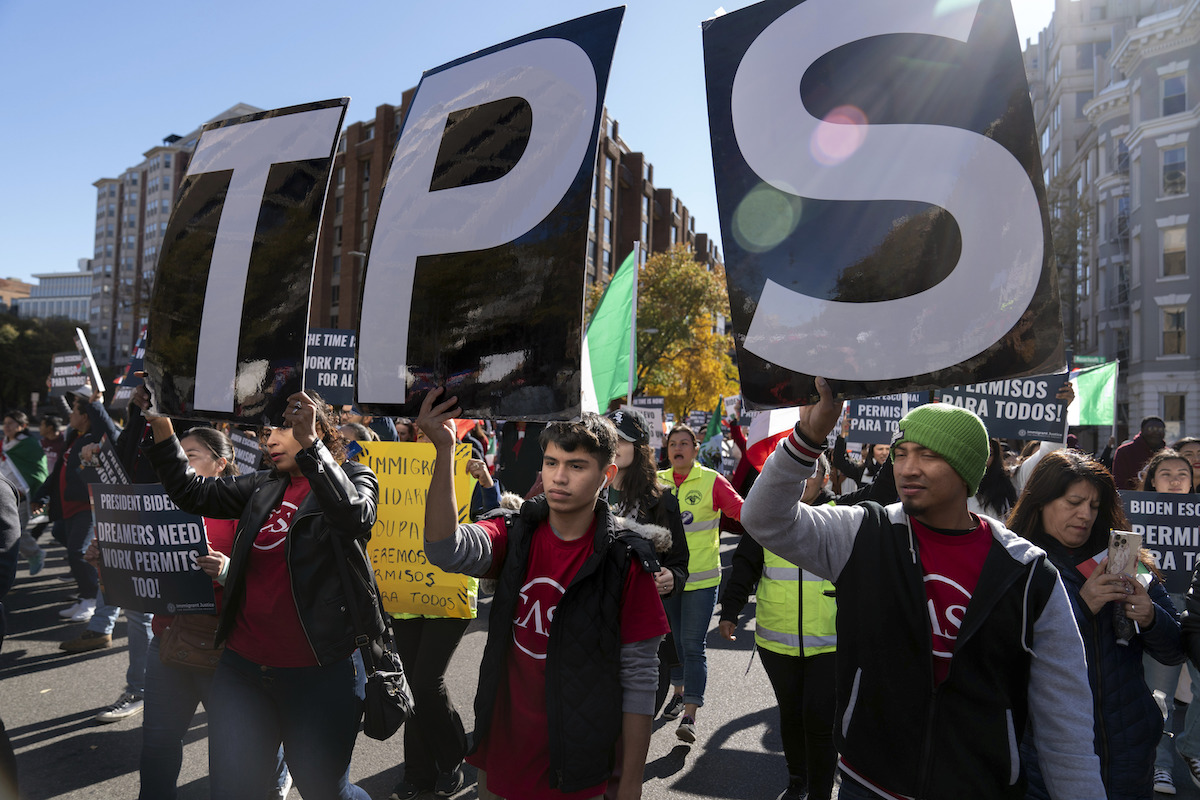Stand up for the facts!
Our only agenda is to publish the truth so you can be an informed participant in democracy.
We need your help.
I would like to contribute

Republican presidential candidate and former President Donald Trump, left, helps serve food to Texas National Guard soldiers, troopers and others who will be stationed at the border over Thanksgiving, Nov. 19, 2023, in Edinburg, Texas. (AP)
If Your Time is short
-
Former Trump immigration adviser Stephen Miller told The New York Times that former President Donald Trump’s immigration proposals include building mass detention camps, overseeing mass deportations, expanding ideological screenings for visa applications, suspending the refugee program, terminating temporary immigration protections and invoking a 1700s-era law to deport people without due process.
-
The Trump campaign pushed back against stories like The New York Times’, calling them “speculative and theoretical.” But Trump’s past policies and his current comments on the campaign trail support most of Miller's account.
-
Many of the promises Miller outlined are likely to run into legal challenges. However, two Supreme Court cases limited the powers of federal courts to issue injunctions in immigration cases.
Building mass detention camps, suspending the refugee program and invoking a centuries-old law to deport people without due process. A key adviser told The New York Times that these are among former President Donald Trump’s immigration plans if he wins the White House in 2024.
Stephen Miller, who led Trump’s first-term immigration agenda, provided The New York Times an overview of Trump’s second-term immigration proposals. Some of the plans mirror Trump’s 2016 campaign promises; others go further.
The Trump campaign pushed back against The New York Times article in a statement saying "reports about personnel and policies that are specific to a second Trump Administration are purely speculative and theoretical."
However, The New York Times said the Trump campaign referred reporters' questions about Trump’s immigration plans to Miller. Additionally, Trump has mentioned many of the plans outlined in The New York Times article in campaign appearances.
Two Supreme Court cases have limited the power federal courts have to halt such plans. Below is an analysis of six proposals Miller outlined, what Trump has said about them, how they fared during Trump’s term and how today’s altered legal landscape could affect their viability.
Sign up for PolitiFact texts
The U.S. has never had enough detention space to hold every person who crosses the border seeking asylum. To combat this, Miller told The New York Times, Trump would build large camps in Texas to detain migrants. He said there are no set plans on how these camps would look, but they would likely resemble detention facilities already on the border. PolitiFact did not find evidence that Trump has publicly spoken about plans to build mass detention camps.
But if he were to build these camps, Trump would need funding from Congress. Miller told The New York Times that if Congress didn’t appropriate sufficient resources to the project, Trump would redirect money from the military budget. The former president did this during his first term. He declared a national emergency in 2019, allowing him to access Defense Department funding for southwest border fencing.
Miller acknowledged that the camps would be used mainly to detain adults traveling without children. Children cannot be detained indefinitely, according to standards set in the 1997 Flores settlement — a court agreement that established national standards for the detention, release and treatment of migrant children. In a CNN town hall Trump did not rule out whether he would bring back the controversial family separation policy, which separated children and parents traveling across the border. Parents were detained, and children were placed in government custody.
In 2019, Trump tried to overturn the Flores settlement to allow for the indefinite detention of family units. However, a federal judge blocked his efforts, and the case didn’t reach the Supreme Court. Miller told The New York Times Trump would try again.
In a September rally in Iowa, Trump once again promised "to carry out the largest domestic deportation operation in American history" by recreating what is known as the "Eisenhower model." That’s a reference to the derogatorily named "Operation Wetback" launched in 1954 by President Dwight D. Eisenhower. Miller discussed plans for mass deportations, but The New York Times didn’t quote him speaking specifically about Eisenhower’s program.
Controversial and sometimes deadly, Eisenhower’s operation utilized hundreds of border patrol officers who carried out raids across the southwestern U.S. and deported agricultural workers it deemed were illegally in the U.S. and sent them to Mexico on trucks, trains, planes and ships.
When Trump talks about taking inspiration from this operation, he doesn’t mention the other part of the "Eisenhower model" — legal immigration opportunities. Immigration officials in the 1950s took what is sometimes called a "carrot and stick" approach. Ramped-up consequences for people entering the country illegally, such as raids and deportations were the stick. And pathways for people to work in the U.S. legally were the carrot: An agreement with Mexico known as the Bracero program provided Mexican farmworkers temporary visas to work in the U.S. Eisenhower’s administration allowed immigration officials to legalize people who had been working illegally on farms by giving them visas on the spot or taking them to the U.S.-Mexico border and allowing them to step over the border and thus legally re-enter the U.S.
During his first administration Trump promised and failed to deport every immigrant who was in the U.S. illegally.
"Under the Trump administration, we will revoke the student visas of radical anti-American and antisemitic foreigners at our colleges and universities and we will send them straight back home," Trump said in Iowa Oct. 16. He said that he would institute "strong ideological screening of all migrants to the United States," to which he added, "If you want to abolish the state of Israel, you’re disqualified. If you support Hamas or the ideology behind Hamas, you’re disqualified. And if you’re a communist, Marxist or fascist, you are disqualified."
PolitiFact reached out to Trump’s campaign to ask what this ideological screening would entail, but we received no response. This was not among the plans that Miller shared with The New York Times.
Federal officials already conduct background checks on applicants, including monitoring social media. But the pro-Palestinian angle is new. Petra Molnar, a lawyer and anthropologist who studies the impacts of migration technologies on people crossing borders, said because this backgrounding technology is already in use, it would not be hard to expand.
But Molnar said doing so raises privacy concerns and could have a chilling effect on public discourse and visa applications."It makes the person feel like they are already a criminal or an unwanted person unless proven otherwise," said Molnar.
According to Miller, Trump plans to revoke the status of hundreds of thousands of people who are allowed to live and work in the U.S. under a variety of protection programs including Temporary Protected Status, Deferred Action for Childhood Arrivals and humanitarian parole. Those programs benefit around 1.4 million people.

Immigrants who have been in U.S. for years, march to the White House Nov. 14, 2023, asking for work permits for Deferred Action for Childhood Arrivals and Temporary Protected Status programs in Washington. (AP)
In 2017 and 2018, Trump tried to end "temporary protected status" designations for around 400,000 people from five countries, including El Salvador. The program provides temporary protections to immigrants whose home countries are considered unsafe. Courts blocked Trump’s attempts, but in September 2020, a federal appeals court ruled Trump could end the protections. According to the 2-1 decision, the Homeland Security secretary, not the court, has the power to grant, extend or terminate temporary protected status.
Miller said Trump would again try to end DACA, the Obama-era program that protects close to 580,000 people from deportation who came to the U.S. illegally as children. Beneficiaries can also apply for two-year work permits.
Trump tried to end the program in 2017, but the U.S. Supreme Court ruled against him in a 5-4 decision. The program’s legality is still up in the air as the case is expected to again land in the Supreme Court.
Hundreds of thousands of immigrants from Cuba, Haiti, Venezuela, Nicaragua, Ukraine and Afghanistan are allowed to live and work in the U.S. temporarily under humanitarian parole programs started by President Joe Biden’s administration. They could also lose their protections, according to The New York Times article.
In a video on Trump’s campaign website, Trump said he would "stop the outrageous abuse of parole authority," and "terminate all work permits for illegal aliens."
During his presidency, Trump drastically cut the refugee program, but this time he's proposing suspending it entirely, according to The New York Times.
Refugees, as defined by U.S. law, are people outside of the U.S. who fled their home countries because of persecution related to race, religion, nationality, political opinion or membership in a particular social group. They have been given refugee protections by the U.S. before they enter the country.
Asylum seekers, on the other hand, also must meet the refugee definition, but they have to be physically present in the U.S. to seek protections.
People can apply for asylum within one year of their arrival, whether they entered the country legally or illegally.
Refugee resettlement is regulated through the Refugee Act of 1980, which standardized resettlement services for all refugees admitted to the United States. The president, in consultation with Congress, determines the highest number of refugees to be resettled in the United States over a fiscal year. So although unprecedented, Trump could technically lower the resettlement caps to zero.
During his first term, Trump paused the refugee resettlement program for 120 days. He considered lowering the cap to zero but instead reduced the cap each year from former President Barack Obama’s limit of 110,000 in fiscal year 2017 to a record low of 15,000 in fiscal year 2021.
Trump has said he plans to invoke a centuries-old law to deport known or suspected gang and drug cartel members from the U.S.
"I’ll also invoke immediately the Alien Enemies Act to remove all known or suspected gang members … the drug dealers, the cartel members from the United States, ending the scourge of illegal alien gang violence once and for all," Trump told Iowa supporters in a Sept. 20 rally.
But he’s likely to run into some legal issues.
The Alien Enemies Act of 1798 was created when the U.S. feared an impending war with France. The law gives the president the ability to arrest, detain and deport people without due process if they are from a country the U.S. is at war with, has been invaded by or has engaged in a raid, legally termed a "predatory incursion." The law was used during the War of 1812, and World Wars I and II.
Trump would face two legal obstacles if he attempted to use the law against gang and cartel members, wrote George Fishman, a legal fellow at the Center for Immigration Studies, a think tank that favors low immigration levels.
-
Gang and cartel activities would have to qualify as an invasion or a "predatory incursion."
-
Gangs and cartels would have to be considered a foreign nation or government, because only actions by these two can trigger the act.
Even if courts agreed there is an invasion of criminal gangs or cartels and that they count as foreign nations or governments, Fishman said there is still another problem: Not all gang and cartel members are from the same country. So, if courts agreed that Mexico, for example, had invaded the U.S., only Mexican citizens could be deported without due process. Suspected cartel members who are citizens of other countries could not be deported using the Alien Enemies Act.
Many of these proposals could run into legal challenges from immigrant-rights groups or Democratic states, as they did during Trump's first term. But Aaron Reichlin-Melnick, policy director at the American Immigration Council, an immigrant-rights advocacy group, wrote a Nov. 13 X post that this time around, it might be more difficult for courts to stop certain policies.
An absence of congressional action on immigration laws for decades has led presidents to make immigration policies and changes via executive actions. In response, states and advocacy groups on all sides sue administrations. These cases often take a long time, so litigants can file injunction requests asking courts to halt policies they claim cause immediate harm or to restart policies they argue prevent harm.
But two 2022 Supreme Court decisions limited federal courts’ power to issue injunctions in immigration cases.
In one case, the Supreme Court said federal courts couldn’t issue injunctions on immigration enforcement, removal or detention policies in classwide lawsuits. Similarly, another case determined lower courts can rule on whether an immigration program is legal but have limited abilities to provide relief or issue injunctions.
However, Reichlin-Melnick said not all of Trump’s immigration proposals deal specifically with immigration law. So, even if they have implications for immigration law, they can be litigated on grounds outside of immigration enforcement. In such cases, federal courts could have more leeway. For example, the Alien Enemies Act falls under the War and National Defense section of the U.S. Code. Reichlen-Melnick said that means if Trump is sued for invoking the law, a federal court could feasibly issue an injunction blocking its use while the case is heard.
Our Sources
The New York Times, Sweeping raids, giant camps and mass deportations: Inside Trump’s 2025 immigration plans, Nov. 11, 2023
The Washington Post, The debunked claims and faux ‘facts’ supporting Trump’s plan to execute drug dealers, Nov. 14, 2022
Immigration History, History The Flores settlement, accessed Nov. 16, 2023
PolitiFact, Did Donald Trump promise mass deportation of 'Latino families'?, July 28, 2016
CNN, Trump plots mass detention and deportation of undocumented immigrants should he regain power, Nov. 11, 2023
Vanity Fair, The Biden campaign warns of "Extreme, racist, cruel" immigration plans under Trump, Nov. 12, 2023
PolitiFact, Donald Trump’s immigration promises: failures and achievements, July 27, 2020
PolitiFact, Trump: Eisenhower deported 1.5 million immigrants, Nov. 11, 2015
Boundless, Trump releases hardline immigration plan ahead of 2024 election, Aug. 21, 2023
Legal Information Institute, 50 U.S. Code § 21 - Restraint, regulation, and removal, accessed Nov. 16, 2023
Politico, Trump officials pressing to slash refugee admissions to zero next year, Jul. 18, 2019
Reuters, How Trump would crack down on immigration in a second term, Nov. 14, 2023
United Nations High Commissioner for Refugees, Convention and protocol relating to the status of refugees
United Nations Treaty Collection - Bureau of population, refugees and migration, History of U.S. refugee resettlement, accessed Nov. 16, 2023
Council on Foreign Relations, How Does the U.S. Refugee System Work?, February 15, 2023
U.S. Department of State, U.S. Refugee Admissions Program, accessed Nov. 16, 2023
American Immigration Council, An Overview of U.S. Refugee Law and Policy, Sept. 20, 2021
Bureau of Population, Refugees and Migration, History of U.S. Refugee Resettlement, accessed Nov. 16, 2023
Politifact, Clarifying the nuances in immigration law after DeSantis sent migrants to Martha’s Vineyard, Sept. 23, 2022





























